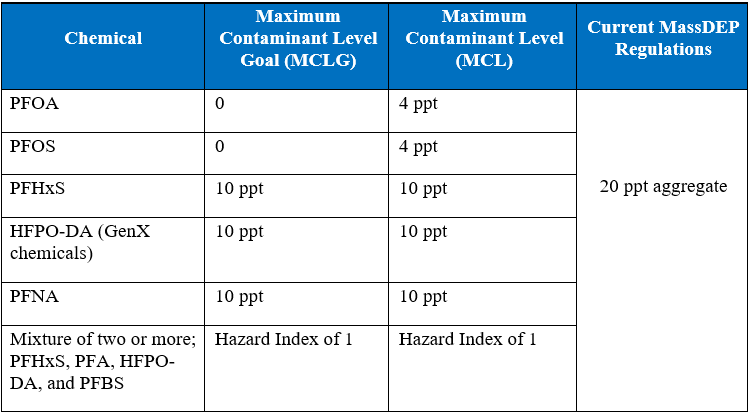Trending publication
EPA’s New PFAS Regulations and What That Means
Print PDFOn April 10, 2024, the U.S. Environmental Protection Agency (“EPA”) announced a National Primary Drinking Water Regulation (the “Regulation”) which established legally enforceable levels called Maximum Contaminant Levels (MCLs) for six PFAS (commonly known as “forever chemicals”) in drinking water. The Regulation establishes an MCL for PFOA, PFOS, PFHxS, PFNA, and HFPO-DA individually, and an MCL for PFAS mixtures containing at least two or more of PFHxS, PFNA, HFPO-DA, and PFBS using a Hazard Index. The Hazard Index is made up of a sum of each chemical’s Health Based Water Concentration, which in turn is the ratio of the chemical found in the drinking water at which no health effects are expected for that substance. The EPA also finalized health-based, non-enforceable Maximum Contaminant Level Goals (MCLGs) for these PFAS. The MCL and MCLG levels established under the Regulation, measured in the parts per trillion, are summarized in the table below and contrasted with current Massachusetts Department of Environmental Protection (“MassDEP”) regulations.

Implementation:
Public Water Systems will be required to sample each Entry Point (i.e., the point at which the water leaves the Public Water System facilities and enters the distribution system) using a monitoring regime generally based on the EPA’s Standard Monitoring Framework for Synthetic Organic Contaminants. Public Water Systems have three years to complete initial monitoring requirements under the Regulation and will then be required to report and summarize PFAS monitoring results and applicable information in Consumer Confidence Reports (“CCRs”), described in the EPA’s “Right to Know” provisions of the Safe Drinking Water Act, beginning in 2027. Public Water Systems must comply with MCLs within five years and will be required to report information regarding any MCL violations, along with required language about the health effects and information about the violations, in public notices and CCRs beginning in 2029.
Cost:
The EPA estimates that implementation of the Regulation will result in $1.5 billion in annual costs that are associated with PFAS monitoring, installation and maintenance of treatment technologies, and obtaining new or additional sources of water. The EPA claims that the Regulation offers Public Water Systems flexibility in terms of which technologies and strategies to employ to achieve compliance, whether that be installing new filtration systems or obtaining new or additional sources of water. Additionally, the Bipartisan Infrastructure Bill included $9 billion in funding to combat PFAS pollution in drinking water, and another $12 billion in funding for drinking water improvements more generally, which can be used to address PFAS pollution.
Massachusetts:
The Regulation will significantly impact Public Water Systems in Massachusetts. MassDEP previously implemented some of the strictest PFAS limits in the country at the time in 2020, limiting Public Water Systems to 20 ppt in aggregate for the six PFAS subject to the Regulation, and has indicated that it will revise its regulations to bring them in line with the stricter limits set out in the Regulation. MassDEP estimates that the 181 Public Water Systems in Massachusetts will be impacted by the Regulation, including 86 systems that were already working with MassDEP prior to the Regulation, due to previously or currently exceeding the Massachusetts drinking water PFAS limits, and 95 PWS that will need to address PFAS pollution for the first time as a result of the new limits. Newly impacted systems will need to consider installing new filtration systems or obtaining new or additional sources of water to achieve compliance with the Regulation.
This advisory was prepared by Matthew Connolly, Matthew Snell, and Joseph Jannetty in Nutter’s Real Estate Department. If you would like additional information, please contact any member of our Real Estate Department or your Nutter attorney at 617.439.2000.
This update is for information purposes only and should not be construed as legal advice on any specific facts or circumstances. Under the rules of the Supreme Judicial Court of Massachusetts, this material may be considered as advertising.


